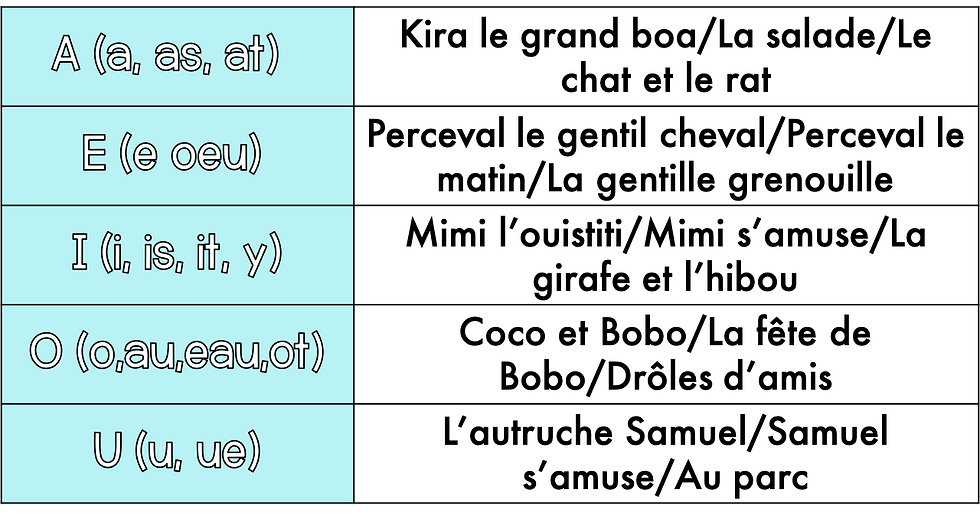What could Scarborough's rope look like when practiced in the primary F.I. classroom?
- FrenchTwistsFSL

- Sep 30, 2020
- 4 min read
In our last blog post, we presented the Scarborough's rope info-graphic as a possible framework for literacy instruction in the primary French Immersion classroom. We reviewed the info-graphic's components in the area of language comprehension and word awareness to better understand those skills which underlie the process of becoming literate. Finally, we posited that an increased focus on word awareness skills in addition to language comprehension would greatly benefit primary FI students as they master becoming literate in French. In this blog, we will consider the following:

POINT TO PONDER #2:
What could Scarborough's rope look like when practiced in the primary F.I. classroom? What instructional material lends itself best to the teaching of both language comprehension and word recognition skills?
In the primary FI classroom, French teachers make a concerted effort to present students with numerous, varied texts on a daily basis. Appropriate, relevant literature is crucial in the primary FI classroom because texts are used as a springboard to develop a host of language comprehension skills. A selected text might be used to support the building of background knowledge in relation to a theme or an inquiry project. A text might be read to students to build vocabulary. Wordless texts are wonderful tools to teach inferencing skills while comptines may highlight a particular sound of the French language code. In fact, texts along with their illustrations are (and should be) a basic staple in any classroom, FI or not.
However, the issue with text selection to address language comprehension skills is that the selected texts seldom offer opportunity for the study of structured word awareness skills. By definition, structured word awareness is explicit and systematic. In other words, the vocabulary offered by a selected text needs to explicitly showcase a particular sound and subsequent text choices must continue to showcase additional sounds in a "logically ordered presentation of concepts and skills that progresses from simple to complex." (Carreker, S page 11). This is where the notion of balanced literacy falls flat. It would prove extremely difficult, if not impossible, for a busy FI teacher to spend time organizing the progression of the French linguistic code all the while attempting to find the right texts to support its instruction in the classroom.
Want to know more about Dr. Suzanne Carreker's article?
Finally, let's assume for a moment that the French texts required to appropriately address both language comprehension and word awareness skills with primary students actually existed. Could FI teachers now begin to address word awareness effectively in the primary classroom? My answer would be: maybe. The reality is that most teachers, whether they teach English or French, may never have been exposed to the concept of phonological awareness let alone understand how to teach these skills to students. In many cases, teachers have been told to avoid explicit phonological or letter-sound instruction thereby rendering the notion of structured literacy as something to be avoided.
Education reporter Emily Hanford addresses these points in her video: At a loss for words. Teachers, through no fault of their own, have been immersed in a whole language culture for so long that they may not know how to teach word awareness skills in the classroom. On the other hand, those teachers who are aware of the benefits of such instruction are fearful of the pushback that they may receive because such structured teaching is reminiscent of traditional phonics programs where words are taught out of context.
Check out At a loss for words:
Accordingly, to support a literacy framework based on Scarborough's rope, material that is text-based offering contextualized, sequenced vocabulary is key. The texts themselves would be used to address language comprehension skills.
The contextualized vocabulary in question can be used to address such skills as:
letter sound correspondences
syllable segmentation and blending
initial/final sound discrimination
rhyme
sound segmentation and blending
In addition, the material needs to provide teachers with practical strategies and tips on how to present word awareness skills to students. So much of student success is dependent on the teacher's ability to present information and concepts effectively. The more we can support teacher learning around word awareness instruction, the more teachers can strategically develop French primary language skills with their students.
ECOUTONS LISONS RIONS: A TEXT-BASED RESOURCE FOR PRIMARY FRENCH IMMERSION STUDENTS THAT SUPPORTS THE DEVELOPMENT OF LANGUAGE COMPREHENSION AND WORD AWARENESS SKILLS
The activities in the Ecoutons, lisons, rions resource target both language comprehension and word awareness skills. The 5 vividly illustrated sound units feature comptines and short texts with contextualized vocabulary allowing for the explicit, sequenced practice of simple vowels and consonants in addition to phonological awareness skills.

In our next series of blogs, we will showcase several key activities from our first sound unit, Kira le grand boa. We will explain our method of presenting texts to primary students so that key second language comprehension skills are practised. We will then show how key vocabulary from the text can be used to introduce French word awareness skills in an explicit, systematic manner.



Comments